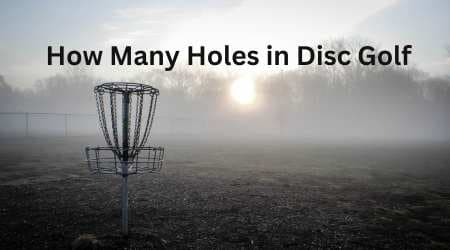
There are 18 holes in a standard disc golf course. Disc golf is a popular recreational sport that involves throwing specialized flying discs into baskets.
The objective is similar to traditional golf, where players aim to complete each hole in the fewest possible throws. Disc golf courses vary in layout, with each hole having a designated par value based on its length and difficulty. While there are primarily 18 holes in a standard course, some courses may have 9 or 27 holes, depending on the size and terrain of the course.
Disc golf is enjoyed by people of all ages and skill levels and can be played individually or in groups. Overall, it's a fun and affordable way to get outside and enjoy the great outdoors.
Understanding Disc Golf And Its Growing Popularity
What Is Disc Golf?
Disc golf is a sport that is growing in popularity, thanks to its similarities to traditional golf, but played with a flying disc. Players throw the disc towards a target (usually a metal basket) with the aim of completing the course in as few throws as possible.
Here are the key aspects of disc golf:
- Course: A typical course has 18 holes, with different distances and obstacles.
- Discs: Players use discs of different types, each designed to have a specific flight path.
- Scoring: Number of throws it takes to get the disc into the target is the player's score. The lower the score, the better.
- Rules: There are different rules to follow, such as mandatory throws, out-of-bounds, and penalty strokes.
How Does It Differ From Traditional Golf?
Although disc golf shares some similarities with traditional golf, there are some significant differences that make it a unique sport that is appealing to many. Here is how it differs from traditional golf:
- Equipment: Disc golf uses flying discs of different types instead of golf clubs and balls.
- Cost: Has lower costs than traditional golf since players only need to buy a set of discs to start playing.
- Accessibility: Golf Disc courses can be designed in smaller areas, making it more accessible to players who live near urban areas.
- Physical demands: Requires less physical effort than traditional golf, as there is no need to carry a heavy bag of golf clubs.
Why Is Disc Golf Becoming Popular?
Disc golf is growing in popularity for several reasons, which we will discuss below:
- Affordable: Disc golf has lower costs than traditional golf, making it accessible to people who want to enjoy a sport without spending too much money.
- Versatile: Can be played in different areas, including parks, recreational areas, and urban spaces. Moreover, it can be played in groups or solo.
- Beginner-friendly: Has a relatively low learning curve than traditional golf, making it a welcome entry point for those just learning to play.
- Eco-friendly: Disc golf has a lower environmental impact than traditional golf, as players do not need to dig up the ground to create holes and do not use carts that emit pollutants.
Disc golf is a fun and exciting sport that is gaining popularity worldwide, thanks to its affordability, versatility, accessibility, and eco-friendliness. It is an excellent option for those who want to enjoy a sport that is both challenging and beginner-friendly.
Read Also: Top 6 Best Disc Golf Discs Of 2023 Reviews And Buying Guide
Origins Of Disc Golf Holes
Disc golfers throw a disc towards a target with the aim of landing in one of the holes scattered throughout the course. However, have you ever wondered where these holes come from? Here is a brief history of the origins of disc golf holes.
History Of Disc Golf Course Design
Disc golf course design has come a long way since the game's inception in the late 1960s. Here are some key points to highlight its evolution:
- First courses used natural objects such as trees as targets for players to aim at
- The first permanent course was established in 1975 by ed headrick, who also invented the first standardized target called the pole hole
- Today, permanent baskets are used as targets and courses are designed with a variety of hole types and layouts to test players' skills
Evolution Of Holes From Trees To Permanent Baskets
Evolution of holes has seen the game's popularity grow immensely. Here are some key points to highlight this evolution:
- The first holes used were trees that players had to hit with their discs
- Pole hole was created in 1975 as a standardized target and replaced natural objects such as trees
- First baskets were invented by harold duvall and were made from wire mesh in the early 1980s
- Modern baskets are constructed with chains that help catch the disc as it approaches the target
Now that you know the history behind disc golf holes, next time you're out on the course, take a moment to appreciate how far the game has come.
Standard Number Of Holes In Disc Golf And Why
Disc golf is undoubtedly one of the most entertaining outdoor sports that people of all ages can enjoy. The game is relatively simple, involves throwing discs, and players aim to hit a target, generally a basket, in as few throws as possible.
However, if you're new to the sport, before setting out to play your first round, it's essential to understand how many holes are in the course and why.
Read Also : Top 5 Best Disc Golf Shoes Of 2023 Reviews & Buying Guide
Pdga Guidelines For Hole Numbers
The professional disc golf association, commonly abbreviated as pdga, is the governing body of disc golf. Their guidelines state that all tournaments should have a minimum of 18 holes. However, tournaments may have more if available. So, it's safe to say 18 is the standard number of holes in disc golf courses.
Factors Influencing The Number Of Holes In A Course
Several factors can influence the number of holes in a disc golf course. These factors may include:
- Amount of available land for a course
- Skill level of the target player demographic
- The time it takes to play a round
- Cost of course maintenance and installation
Commonly Found Numbers Of Holes In Courses
While the standard number of holes in a disc golf course is 18 holes, it is not unusual to find courses that have more or fewer holes. Thus, common numbers of holes in courses may include:
- 9-hole courses: These courses are perfect for beginners or those who have limited time. They are usually less challenging and take approximately 45 minutes to an hour to complete.
- 18-hole courses: This is the most common number of holes in disc golf courses and is ideal for intermediate players. It usually takes two to three hours to complete.
- 27-hole courses: This is a standard number of holes in advanced level disc golf courses. They take a longer time to play and are more challenging.
- 36-hole courses: These are considered the most challenging and are ideal for seasoned players seeking a test of their skills.
Understanding the number of holes in disc golf courses is essential for players, especially when planning for a game. The standard number of holes is 18, but courses may have more or fewer holes depending on several factors. Before heading out to play, make sure to research the number of holes in the course, so you know what to expect concerning the course layout, time commitment, and difficulty level.
Read Also : Best Disc Golf Baskets Of 2023 With Reviews And Buyers Guide
Variations In Hole Count And Course Layouts
Disc golf is a fascinating sport that requires accurate throws to land the disc into a metal basket-style target. It originated in the 1960s and has since grown immensely in popularity. The number of holes in a disc golf course varies widely, and the layouts present unique challenges to players.
In this blog post, we'll discuss the hole count and course variations in disc golf.
Unique Course Designs And Their Benefits
Disc golf is all about strategy and skill, and courses with unique designs make the game even more interesting.
Here are some benefits of unique course designs:
- Facilitates a wide variety of shots and techniques.
- Increases the challenge and skill level for experienced players.
- Boosts creativity and ingenuity in the gameplay.
- Increases the enjoyment factor of the game and provides an excellent opportunity for social interaction.
Some unique course design examples include:
- Island greens course: This type of course features a green around a water hazard, which players must avoid when attempting to land their disc into the target.
- Forest courses: Theses courses require players to throw their disc through the trees, bushes, and other obstacles, forcing them to use tricky shots and techniques.
Courses With Fewer Holes – A Double Edged Sword
The number of holes in a disc golf course can impact the gameplay and the overall experience. While some courses have as few as 9 holes, others can have up to 27. Here are some pros and cons of courses with fewer holes:
Pros:
- Faster gameplay and quicker rounds.
- Lower cost for upkeep and maintenance.
- Great for beginners who are still learning the sport.
Cons:
- Less variety and challenge for skilled players.
- Less time on the course and fewer opportunities to socialize during the game.
Case For More Holes – A Golfer'S Perspective
Golfers who fancy a challenge often prefer courses with more holes. Here are some benefits of playing on a course with more holes:
- Provides a greater variety of shots and techniques to master.
- Fosters perseverance and mental toughness.
- Provides golfers with more playtime and opportunities to interact with their fellow players.
Some courses have as many as 27 holes, which is ideal for professionals and experienced players who want to challenge their skills and endurance.
The hole count and course layout in disc golf vary widely, providing a unique experience for players of different levels. The sport's growth and popularity have led to interesting course designs that add spice to the game. Players can choose a course that fits their skill level and provides them with the kind of gameplay experience they desire.
Whether you're a beginner or a professional, disc golf is a sport that can provide you with countless hours of entertainment.
Landscape Considerations
Disc golf is a sport that requires players to throw a disc into a designated target area. The rules of the game are simple, and players earn points by throwing the disc into the target with as few throws as possible.
However, creating a disc golf course that is both challenging and enjoyable requires careful consideration of the landscape. We will explore some of the landscape considerations that come into play when designing a disc golf course, including natural features, topography and elevation, and vegetation types.
Natural Features Suitable For Course Design
When designing a disc golf course, you must consider the natural features of the land. Here are some of the natural features that are suitable for course design:
- Open spaces: Large, open areas are ideal for creating long, challenging holes that require players to throw the disc over long distances.
- Woods and forests: These areas provide natural barriers and obstacles, and can be used to create shorter, more technical holes.
- Water features: Ponds, streams, and rivers add an extra element of challenge and risk to the game, and can be used to create both short and long holes.
- Hills and valleys: Elevation changes add another layer of difficulty to the game, and can be used to create challenging holes that require players to throw up or down slopes.
Role Of Topography And Elevation Changes In Hole Count
Topography and elevation changes play a significant role in the number of holes that can be included in a disc golf course. Here are some key points to consider:
- Slopes and hills: Each hill or slope can add multiple holes to the course. For example, a steep hill could include five holes, starting at the top and ending at the bottom.
- Gaps and valleys: These natural features can be used to create tunnels and obstacles that require players to throw with more accuracy.
- Flat areas: While flat areas don't add much to the course in terms of difficulty, they can be used to create short, technical holes.
Vegetation Types Suitable For Disc Golf Courses
Vegetation types also play an important role in the design of a disc golf course. Here are some of the vegetation types that are suitable for disc golf courses:
- Trees: Trees provide natural obstacles and can be used to create challenging, technical holes. However, it's important to avoid trees with low-hanging branches that could interfere with players' throws.
- Shrubbery: Low-growing shrubs can create natural barriers that require players to throw with more accuracy. However, it's important to avoid shrubs that are thorny or otherwise damaging to the disc.
- Grass: While grass doesn't add much to the difficulty of the course, it's important to keep it well-maintained so that players can easily locate their discs.
Overall, designing a disc golf course requires careful consideration of the landscape and natural features. By taking into account these factors, you can create a course that is both challenging and enjoyable for players of all skill levels.
Space Constraints And Layouts
Disc golf is a popular sport that is enjoyed by many enthusiasts. While the game itself may be simple, the number of holes and their layouts can vary depending on the location. In this post, we’ll delve into the impact of space constraints on hole count and different layouts available for disc golf courses.
Finding Enough Space And The Impact On Hole Count
One of the biggest challenges when designing a disc golf course is finding enough space to accommodate the holes. Most courses require at least 30 acres of land, although it is possible to design a course with less.
Here are the key points to consider when designing the layout of a disc golf course:
- A standard course requires 18 holes, but some courses may have fewer or more holes depending on the available space.
- Using shorter holes can reduce the amount of land needed to build the course.
- The location and terrain of the course can also impact the number of holes possible.
Single Vs. Multiple Course Layouts
Another factor that can impact the layout of disc golf courses is whether they are designed as a single course or multiple courses. The key differences between these layouts are:
- Single course layout: A single course is designed to be played in one round. The course often has a loop layout where players end up back at the starting point.
- Multiple course layouts: Multiple courses consist of two or more courses that are designed to be played separately or in combination. These courses can be designed to have different skill levels and lengths.
Impact Of Hole Count On The Length Of Play
Another aspect to consider when designing a disc golf course is the impact of the number of holes on the length of play. Shorter courses can be completed in a shorter amount of time, while longer courses can take several hours to complete.
Here are some key points to consider:
- The average time to complete an 18-hole course is about 2 to 2.5 hours.
- Longer courses may have more holes or longer distances between holes that require more walking.
- Shorter courses can accommodate players who want a quicker game or have less time to play.
Designing a disc golf course can be challenging, but considering the impact of space constraints and layouts can help you create an engaging and enjoyable experience for players. Whether you choose single or multiple course layouts, the hole count can impact the length of play, and designing a course that fits the available space is crucial.
Positive Effects Of Disc Golf On Communities
Disc golf is gaining popularity worldwide as it is a fun and affordable way for individuals to enjoy the outdoors and engage in physical activity. However, it is not just a leisure activity as it has proven to have several positive effects on communities.
Growth Of Disc Golf Tourism
Disc golf tourism has been on the rise as the sport gains popularity among players and spectators alike. There are now more disc golf courses than ever before, attracting players from different regions and countries. This trend has significant economic benefits for the communities that host these courses, including:
- Increase in tourism revenue
- Boost in demand for local accommodation
- Increase in sales for restaurants and merchandisers
- Job creation
Opportunities For Local Businesses And Services
Disc golf courses play an essential role in attracting businesses to the surrounding areas. As more people come to play, there is an ever-increasing need for essential services such as:
- Gift shops and pro shops offering disc golf gear, souvenirs, and snacks
- Lodging for players, including hotels and rental apartments
- Food services, including restaurants, cafes and food trucks
- Disc golf lessons and clinics offered by experienced players
Role Of Disc Golf Courses In Community Development
Disc golf courses offer more than just recreational opportunities for players. They can also contribute to community development in several ways, including:
- Providing a space for community events and gatherings
- Promoting physical activity and healthy lifestyle choices
- Encouraging environmental stewardship and conservation efforts
- Fostering social connections among players and community members
Disc golf has a significant impact on communities, contributing to their economic and social development. As the sport continues to gain popularity, we can expect even more opportunities for growth, development, and community engagement.
Negative Effects Of Disc Golf On Communities
Disc golf is a popular sport played in parks and other open spaces, but it can have negative impacts on the communities where it is played. Here are some of the ways disc golf can negatively affect communities:
Negative Environmental Impact
Disc golf courses can have a negative impact on the environment. Here are some ways that disc golf courses may contribute to environmental damage:
- Deforestation or destruction of habitat in order to build the course
- Soil degradation and erosion caused by the trampling of players and spectators
- Littering and pollution from players who leave trash and food behind
- Damage to trees caused by players using them as targets
- The use of heavy machinery, pesticides and herbicides for course maintenance impacting the local ecosystem
Noise And Traffic
Disc golf courses can also cause problems with noise and traffic. Here are some ways in which disc golf can create these issues:
- Sudden screams or loud voices of excitement when someone makes an impressive shot, leading to disturbance to nearby residents.
- Sound from players engaging in friendly talk and chatter during their games leading to noise pollution in the local communities.
- Increase of vehicles, people and the occasional road closures to parking space associated with disc golf tournaments causes road traffic in the area.
Conflicts With Other Activities In Parks
Disc golf courses may disrupt other activities that take place in parks and open spaces. Here are some ways that conflicts between disc golf and other activities can create issues:
- Collisions between players and other park users during games
- People getting hit by flying discs
- Competition with priority-space among disc golf players and families picnicking
- Crowding in the park due to large groups congregating around the course, hindering other recreational activities.
While disc golf provides a fun and engaging outlet for recreation, it may negatively impact communities due to the environmental, noise and traffic, and interpersonal conflicts created. Responsible courses management and proper etiquette can mitigate negative effects, thereby promoting peaceful and healthy coexistence between disc golf and the local community.
Evolution Of Disc Golf Course Design
Disc golf enthusiasts know that courses usually consist of 18 holes. However, the history of disc golf courses features numerous differences and changes. The thing is, golf courses are now evolving and adapting to the modern needs of players. Let's take a closer look at the evolution of disc golf course design, paying particular attention to the potential for changes in the number of holes and the role of technology and innovation.
Potential For Changes In Number Of Holes
In the early days of disc golf, courses were more casual, and the number of holes varied widely, from as few as 6 to as many as 30. Today, most disc golf courses feature 18 holes, mirroring traditional ball golf courses.
However, optimization of land use and the need for time-efficient gameplay have led to alternative course designs featuring fewer holes.
- In recent years, 12-hole courses have become increasingly popular, with many courses designed to be played in a shorter time frame.
- 9-hole courses are also common, often set up in smaller urban areas where space is limited.
- 24-hole courses exist, providing an extra challenge for players and a longer playing experience.
- Some unique courses come in strange configurations. One, in particular, features 27 holes arranged in a cube!
Role Of Technology And Innovation
Modern technology has brought numerous innovations to disc golf course design, revolutionizing the way courses are designed and played. Here are some significant advancements in the field:
- Gps mapping tools have helped designers in creating detailed, accurate course maps.
- Lidar (light detection and ranging) technology has facilitated the creation of 3d models for more accurate land analysis and course design.
- Mapping drones are used to capture more extensive and precise aerial views of the courses, providing designers with a clear picture of the terrain and landforms.
- Innovative course features, like basket-mounted torque meters and infrared shot detectors, enhance playing experience and raise the level of competitiveness among players.
Evolution of disc golf course design shows that the sport is still growing and changing, adapting to the modern needs of players. With the aid of technology, course designers can create accurate and innovative designs that cater to all levels and styles of play.
Who knows, we might see even more changes in the future of disc golf course design!
Frequently Asked Questions For How Many Holes In Disc Golf
How Many Holes Are Typically In A Disc Golf Course?
Most courses have 18 holes, but some courses have 9 or 24 holes. The length of each hole can range from 150 to 1000 feet depending on the size and layout of the course.
What Types Of Holes Are In Disc Golf?
Most common types of disc golf holes are par 3 and par 4 holes. Par 3 holes are shorter and can be completed in one shot, while par 4 holes require two or more shots to complete.
How Deep Are The Holes In Disc Golf Courses?
Holes in disc golf courses, also known as baskets, are typically 24 inches deep. The top of the basket is 3 feet off the ground, and the basket has a diameter of around 21 inches.
How Many Discs Should I Bring To A Disc Golf Course?
It's usually best to bring at least 3 discs with you to a disc golf course, including a driver, mid-range, and putter. This will give you the ability to make various types of shots and navigate the course effectively.
Can I Play Disc Golf Alone Or Do I Need A Partner?
You can play disc golf alone or with a partner. However, playing with others can make the game more enjoyable and competitive. Many disc golf courses have leagues and tournaments for players to participate in.
Conclusion
It's apparent that disc golf has grown to become a popular sport with several courses around the world, each having unique hole layouts. The number of holes on a disc golf course can differ based on several factors, including but not limited to the course design, available land, and skill level of players.
Courses typically have 9, 18, or 27 holes, but the numbers can go up to even 36 or more. The course's challenge level also varies with the number of holes and their design. Overall, disc golf courses seek to provide a fun and challenging experience for players of all levels.
As the sport's popularity continues to rise, we can expect to see more courses with creative hole designs and layouts, providing disc golfers around the world with an exciting and enjoyable experience.





